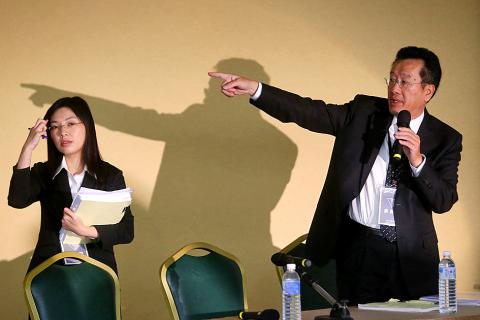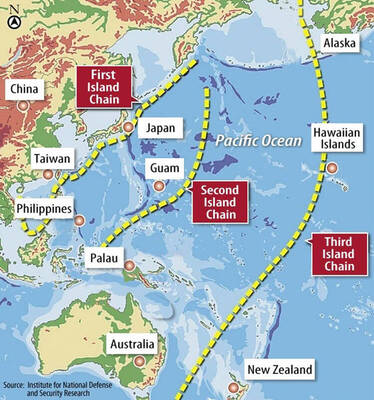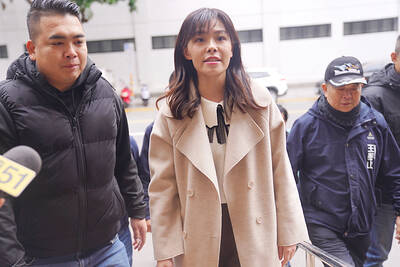The Ill-gotten Party Assets Settlement Committee yesterday consulted historians and former officials at the China Youth Corps at a hearing in Taipei to determine whether the corps is a Chinese Nationalist Party (KMT) affiliate, but questions surrounding the foundation’s operations remained.
The committee’s investigation report found that the corps — known as the China Youth Anti-Communist National Salvation Corps until 2000 — was founded in 1952 after a resolution by the then-KMT Central Reform Committee in an effort to “depose Chinese communists and resist Soviet Union forces” following the KMT’s defeat in the Chinese Civil War and its retreat to Taiwan.
It organized camps to teach combat skills to young people at high-school level and above under the control of the Ministry of National Defense until 1969, when then-president Chiang Kai-shek’s (蔣介石) son, then-minister of national defense Chiang Ching-kuo (蔣經國), took over as premier, the committee said.

Photo: CNA
The budgets granted to the corps by central government agencies were received by the then-KMT Central Committee (now the KMT Central Standing Committee), which distributed the money to the corps, it said.
The corps later underwent a transformation and started organizing a variety of activities — including art classes, hiking and camping groups, and school graduation trips — and was designated a social organization overseen by the Executive Yuan, the committee said.
In 1989, it was registered as a private foundation, it said.
Asked by committee Chairman Wellington Koo (顧立雄) why the then-KMT Central Committee had received the money on behalf of the corps, corps deputy chief executive Cheng Fei-wen (鄭斐文) said he did not know.
Koo asked Chinese Cultural University history professor Tung Pao-cheng (董保城) whether the corps’ “instantaneous” transition from a government agency to a social organization, and later to a foundation, ran counter to social justice, since all its resources came from the central government.
Tung replied that during the Martial Law era, people were banned from forming groups and so the corps was monitored by the Executive Yuan.
After the Civil Associations Act (人民團體法) was passed in 1989, the corps was promptly registered as a foundation because it met all the qualifications, Tung said.
Koo asked former corps secretariat director Chao Ling-cheng (趙令正) why a number of members have doubled as presidents of education and cultural firms and foundations established by the corps.
Saying that the then-KMT government required all people aged between 16 and 25 to join the corps, he asked Chao why the corps’ size has shrunk to just 100 members.
Chao could not answer either question, saying the issues were not within his purview.
Former Academia Historica secretary-general Chen Li-wen (陳立文) said that she did not know whether the corps had returned the capital granted to it by the central government, but, as far as she knew, the corps used the majority of its funds on its work and organizing youth activities.
Koo said in an interview during an afternoon break that although information on how the corps acquired its funds was insufficient, the issue should not be dropped just because the corps was formed during the party-state era.
The committee is to focus its efforts to trace the cash flow to the corps between 1952 and 1969 by requesting more data from the Ministry of National Defense, he said.

The US government has signed defense cooperation agreements with Japan and the Philippines to boost the deterrence capabilities of countries in the first island chain, a report by the National Security Bureau (NSB) showed. The main countries on the first island chain include the two nations and Taiwan. The bureau is to present the report at a meeting of the legislature’s Foreign Affairs and National Defense Committee tomorrow. The US military has deployed Typhon missile systems to Japan’s Yamaguchi Prefecture and Zambales province in the Philippines during their joint military exercises. It has also installed NMESIS anti-ship systems in Japan’s Okinawa

‘WIN-WIN’: The Philippines, and central and eastern European countries are important potential drone cooperation partners, Minister of Foreign Affairs Lin Chia-lung said Minister of Foreign Affairs Lin Chia-lung (林佳龍) in an interview published yesterday confirmed that there are joint ventures between Taiwan and Poland in the drone industry. Lin made the remark in an exclusive interview with the Chinese-language Liberty Times (the Taipei Times’ sister paper). The government-backed Taiwan Excellence Drone International Business Opportunities Alliance and the Polish Chamber of Unmanned Systems on Wednesday last week signed a memorandum of understanding in Poland to develop a “non-China” supply chain for drones and work together on key technologies. Asked if Taiwan prioritized Poland among central and eastern European countries in drone collaboration, Lin

BACK TO WORK? Prosecutors said they are considering filing an appeal, while the Hsinchu City Government said it has applied for Ann Kao’s reinstatement as mayor The High Court yesterday found suspended Hsinchu mayor Ann Kao (高虹安) not guilty of embezzling assistant fees, reducing her sentence to six months in prison commutable to a fine from seven years and four months. The verdict acquitted Kao of the corruption charge, but found her guilty of causing a public official to commit document forgery. The High Prosecutors’ Office said it is reviewing the ruling and considering whether to file an appeal. The Taipei District Court in July last year sentenced Kao to seven years and four months in prison, along with a four-year deprivation of civil rights, for contravening the Anti-Corruption

NO CONFIDENCE MOTION? The premier said that being toppled by the legislature for defending the Constitution would be a democratic badge of honor for him Premier Cho Jung-tai (卓榮泰) yesterday announced that the Cabinet would not countersign the amendments to the local revenue-sharing law passed by the Legislative Yuan last month. Cho said the decision not to countersign the amendments to the Act Governing the Allocation of Government Revenues and Expenditures (財政收支劃分法) was made in accordance with the Constitution. “The decision aims to safeguard our Constitution,” he said. The Constitution stipulates the president shall, in accordance with law, promulgate laws and issue mandates with the countersignature of the head of the Executive Yuan, or with the countersignatures of both the head of the Executive Yuan and ministers or